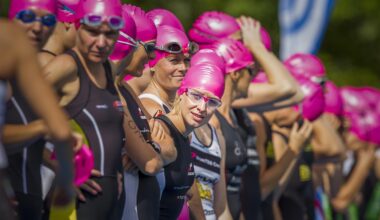Combining Jump Float Serve with Other Serving Techniques
The jump float serve is a highly effective technique in volleyball, requiring a unique blend of timing and precision. To master this skill, players must first develop a strong fundamental understanding of the basic float serve. Incorporating elements from other serving techniques can significantly enhance a player’s effectiveness on the court. By using drills that target both the jump float and traditional float serves, players can improve their serving metrics. Understanding the physics behind each serve contributes to developing a powerful and unpredictable serve. Focusing on body positioning, wrist action, and follow-through ensures that players deliver accurate serves repeatedly. This kind of practice allows players to adapt their serving strategy dynamically during matches. Moreover, players can pair the jump float serve with other techniques, such as the top-spin serve. This variety keeps opponents guessing and often leads to scoring opportunities. For the best results, integrating multiple techniques into practice sessions can greatly enhance performance and adaptability. Coaches should also encourage players to experiment with different strategies, helping to develop their individual serving style.
Drills for Jump Float Serve Mastery
Incorporating specific drills into training can dramatically improve a player’s jump float serve. These drills should focus on three main components: approach, jump, and contact. A good drill starts with a proper approach, which involves quick footwork. For instance, players can practice their three-step approach, emphasizing explosive movement. Next, the jump phase should be refined to optimize height and power. Players need to focus on timing and body coordination during this phase. Another crucial aspect is the contact point when striking the ball. Players should aim to hit the ball at the highest point of their jump. Coaches can use various training aids, such as throwing a volleyball into a coin target placed on the court, to provide feedback. Additionally, video analysis can help players visually dissect their form. Recording practices can reveal areas for improvement and reinforce effective technique. Pairing the jump float serve drills with conditioning exercises also builds strength and agility, further contributing to overall performance. Finally, regular assessment and feedback sessions are essential for steady progress during training.
Understanding timing and angles is vital when executing your jump float serve properly. Players can significantly enhance their performance by focusing on how body positioning affects serve outcomes. A good jump float serve depends not just on power but also on strategic placement. By varying angles and height, players can keep opponents on their toes. Visualizing where the ball will land aids in achieving targeted placements, and practicing these visuals enhances court awareness. Additionally, incorporating feedback from teammates during practice helps players refine their technique. Working in pairs can promote quick adjustments to each other’s serving performance. Players can also practice serving to different zones on the court, testing their accuracy and variability. This targets both skill enhancement and opponent unpredictability. The challenge during matches, however, is executing these techniques under pressure. Mimicking high-stakes scenarios during training can prepare players for competitive settings. Effective practice adds layers of complexity and challenges, which ultimately boosts confidence and skill. As players develop their jump float serve, they should remember to maintain balance with other serving styles for a well-rounded game.
Incorporating Team Strategies with Serving Techniques
It’s essential that players understand how their jump float serve fits into the broader team strategy. A well-executed serve can set the stage for a successful rally, putting pressure on the opposing team from the start. Coaches can devise team tactics incorporating various serve types to disrupt the opponents’ rhythm. When players master the jump float serve, they can collaborate with setters, attacking different areas of the opponent’s defense. Additionally, understanding the flow of the game can lead to strategic serving setups. For example, if the opposing defense weakens in a specific area, players should focus their jump float serves there. By encouraging open communication, teams can share observations in real-time about opponent weaknesses. Regularly reviewing footage of their games can also inform players about effective serving placements and situations. Teams should analyze these strategies both offensively and defensively, which can be a valuable exercise in performance evaluation. Balancing individual strengths with team strategies is crucial for enhancing overall play and effectiveness during critical match situations.
As training progresses, it’s crucial to develop mental resilience alongside physical skills. Players should partake in exercises that enhance focus and reduce anxiety during serving. Visualization techniques can greatly aid with this, allowing athletes to mentally rehearse successful jump float serves. Focusing on positive outcomes can reduce pressure during actual matches. Additionally, mindfulness practices, such as deep breathing and meditation, can cultivate calmness under pressure. This helps players maintain composure in high-stakes moments. Encouraging a growth mindset during training promotes a culture of learning, where mistakes are seen as opportunities for improvement. Emphasizing positivity helps to build confidence in the player’s abilities. Moreover, incorporating challenges, such as competitive drills, encourages friendly rivalry among teammates. These challenges foster teamwork and elevate the overall training experience. Coaches must guide players through mental conditioning strategies and allow them to navigate these challenges. Balancing the mental and physical aspects of volleyball ensures holistic development, which is essential for lasting success on the court. With effective practices in place, players can seamlessly combine their jump float serves with other effective serving techniques.
Evaluating Serving Techniques and Progress
To measure the effectiveness of jump float serves, a clear evaluation system must be established. Coaches should employ metrics to analyze serving performance in both training and competition. Key performance indicators could include accuracy, speed, consistency, and opponent reception. Regular feedback is essential and should involve both self-evaluation and peer feedback. Players can maintain serving journals to track their sessions, noting areas of strength and those needing improvement. This personal record is integral for reinforcing positive habits. Moreover, setting specific goals can motivate players towards a tangible target as they work on their jump float serve. Coaches can introduce performance benchmarks that players should strive to achieve, creating a sense of urgency in their training. End-of-season reviews can also offer insight into how well players have adapted their techniques. This assessment encompasses growth over time, revealing areas of focus moving forward. Another crucial element is the implementation of team-wide assessments that highlight both individual and collective progress. This openly fosters a culture of accountability among teammates, thereby enhancing overall training quality.
The integration of feedback is crucial in combining jump float serves with other techniques. Coaches must ensure a continuous loop of communication, allowing players to express their challenges and successes during practice. Encouraging players to vocalize their experiences promotes an atmosphere of collaboration and understanding. Players can rely on their peers for insight into techniques that resonate with them, leading to professional growth. Furthermore, analyzing practice sessions together can help isolate key techniques that need refinement. Visual aids can aid in this process; players can watch demonstration videos of themselves or others to reinforce proper execution. This analysis aids in bridging gaps in their performance. Furthermore, fostering an open environment where everyone learns from their mistakes encourages a positive atmosphere. As players combine various serving styles, seeing improvement often boosts morale. Celebrating even small victories is essential to motivate players, leading to consistent development. Working together as a cohesive unit produces better outcomes. With continuous effort and attention to feedback, players can successfully incorporate the jump float serve alongside other diverse serving strategies.
Final Reflections on Serve Techniques
The development of a jump float serve and its integration with other serving techniques offers a comprehensive approach to volleyball training. Mastering various styles contributes to a player’s versatility on the court. With consistent practice and feedback, players can adapt their serves, becoming formidable opponents. Focused drills, strategic planning, and mental resilience play a pivotal role in this journey. Establishing a supportive training environment helps to cultivate unique serving skills in each player. A blend of individual and team strategies encourages players to push their limits, exposing them to different aspects of serving. Coaches also play a significant role in guiding athletes through personalized training plans. For longevity in sports, maintaining physical health and injury prevention is crucial too. As players embark on their journey to master the jump float serve, they also enrich their overall understanding of the game. This combination leads to heightened performance and deeper insight into volleyball dynamics. Birds of a feather train together; these experiences offer valuable lessons that resonate throughout a player’s career. By embracing every challenge, players fortify their skills and enjoyment of volleyball.


